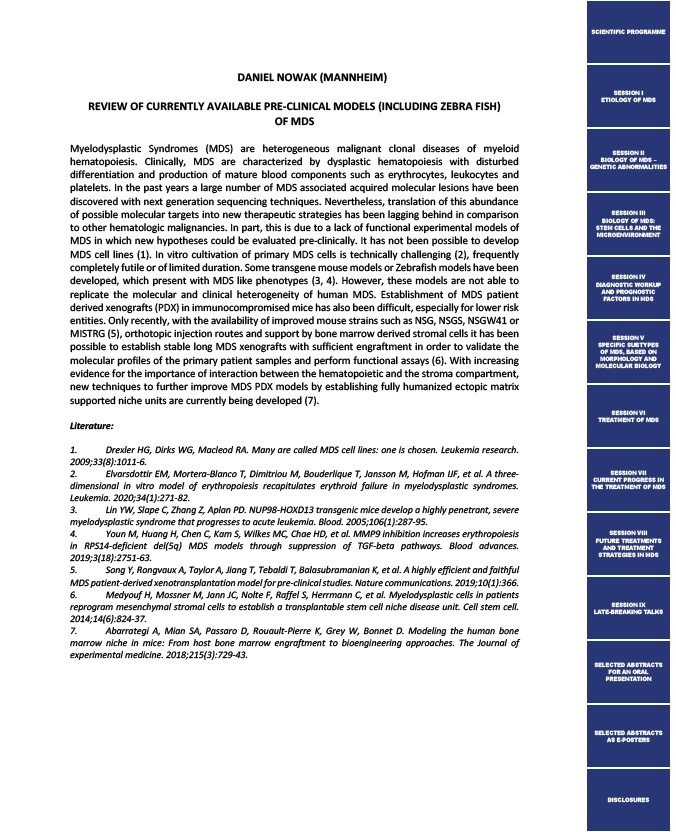
DANIEL NOWAK (MANNHEIM)
REVIEW OF CURRENTLY AVAILABLE PRE-CLINICAL MODELS (INCLUDING ZEBRA FISH)
OF MDS
Myelodysplastic Syndromes (MDS) are heterogeneous malignant clonal diseases of myeloid
hematopoiesis. Clinically, MDS are characterized by dysplastic hematopoiesis with disturbed
differentiation and production of mature blood components such as erythrocytes, leukocytes and
platelets. In the past years a large number of MDS associated acquired molecular lesions have been
discovered with next generation sequencing techniques. Nevertheless, translation of this abundance
of possible molecular targets into new therapeutic strategies has been lagging behind in comparison
to other hematologic malignancies. In part, this is due to a lack of functional experimental models of
MDS in which new hypotheses could be evaluated pre-clinically. It has not been possible to develop
MDS cell lines (1). In vitro cultivation of primary MDS cells is technically challenging (2), frequently
completely futile or of limited duration. Some transgene mouse models or Zebrafish models have been
developed, which present with MDS like phenotypes (3, 4). However, these models are not able to
replicate the molecular and clinical heterogeneity of human MDS. Establishment of MDS patient
derived xenografts (PDX) in immunocompromised mice has also been difficult, especially for lower risk
entities. Only recently, with the availability of improved mouse strains such as NSG, NSGS, NSGW41 or
MISTRG (5), orthotopic injection routes and support by bone marrow derived stromal cells it has been
possible to establish stable long MDS xenografts with sufficient engraftment in order to validate the
molecular profiles of the primary patient samples and perform functional assays (6). With increasing
evidence for the importance of interaction between the hematopoietic and the stroma compartment,
new techniques to further improve MDS PDX models by establishing fully humanized ectopic matrix
supported niche units are currently being developed (7).
Literature:
1. Drexler HG, Dirks WG, Macleod RA. Many are called MDS cell lines: one is chosen. Leukemia research.
2009;33(8):1011-6.
2. Elvarsdottir EM, Mortera-Blanco T, Dimitriou M, Bouderlique T, Jansson M, Hofman IJF, et al. A three-dimensional
in vitro model of erythropoiesis recapitulates erythroid failure in myelodysplastic syndromes.
Leukemia. 2020;34(1):271-82.
3. Lin YW, Slape C, Zhang Z, Aplan PD. NUP98-HOXD13 transgenic mice develop a highly penetrant, severe
myelodysplastic syndrome that progresses to acute leukemia. Blood. 2005;106(1):287-95.
4. Youn M, Huang H, Chen C, Kam S, Wilkes MC, Chae HD, et al. MMP9 inhibition increases erythropoiesis
in RPS14-deficient del(5q) MDS models through suppression of TGF-beta pathways. Blood advances.
2019;3(18):2751-63.
5. Song Y, Rongvaux A, Taylor A, Jiang T, Tebaldi T, Balasubramanian K, et al. A highly efficient and faithful
MDS patient-derived xenotransplantation model for pre-clinical studies. Nature communications. 2019;10(1):366.
6. Medyouf H, Mossner M, Jann JC, Nolte F, Raffel S, Herrmann C, et al. Myelodysplastic cells in patients
reprogram mesenchymal stromal cells to establish a transplantable stem cell niche disease unit. Cell stem cell.
2014;14(6):824-37.
7. Abarrategi A, Mian SA, Passaro D, Rouault-Pierre K, Grey W, Bonnet D. Modeling the human bone
marrow niche in mice: From host bone marrow engraftment to bioengineering approaches. The Journal of
experimental medicine. 2018;215(3):729-43.
SCIENTIFIC PROGRAMME
SESSION I
ETIOLOGY OF MDS
SESSION II
BIOLOGY OF MDS –
GENETIC ABNORMALITIES
SESSION III
BIOLOGY OF MDS:
STEM CELLS AND THE
MICROENVIRONMENT
SESSION IV
DIAGNOSTIC WORKUP
AND PROGNOSTIC
FACTORS IN MDS
SESSION V
SPECIFIC SUBTYPES
OF MDS, BASED ON
MORPHOLOGY AND
MOLECULAR BIOLOGY
SESSION VI
TREATMENT OF MDS
SESSION VII
CURRENT PROGRESS IN
THE TREATMENT OF MDS
SESSION VIII
FUTURE TREATMENTS
AND TREATMENT
STRATEGIES IN MDS
SESSION IX
LATE-BREAKING TALKS
SELECTED ABSTRACTS
FOR AN ORAL
PRESENTATION
SELECTED ABSTRACTS
AS E-POSTERS
DISCLOSURES